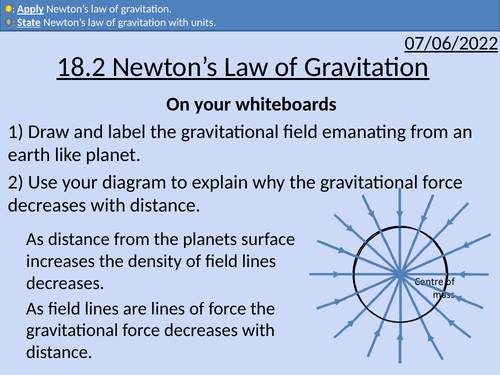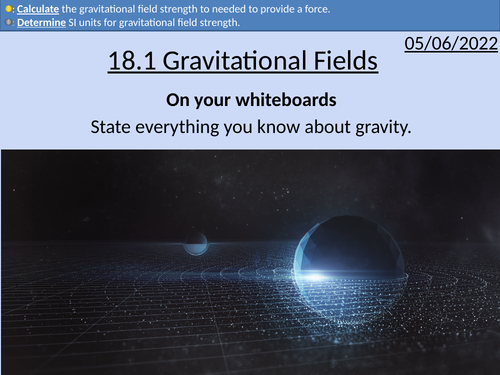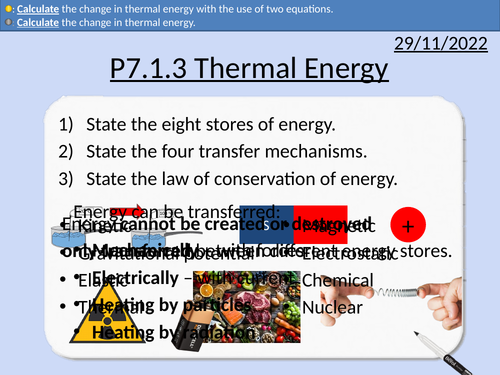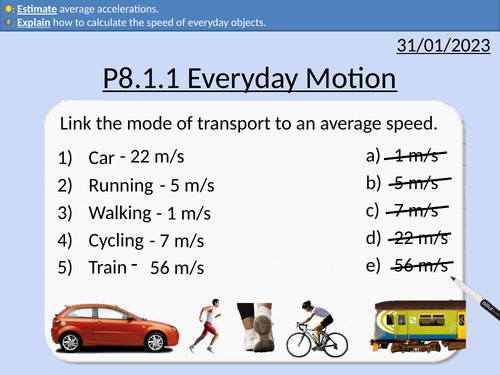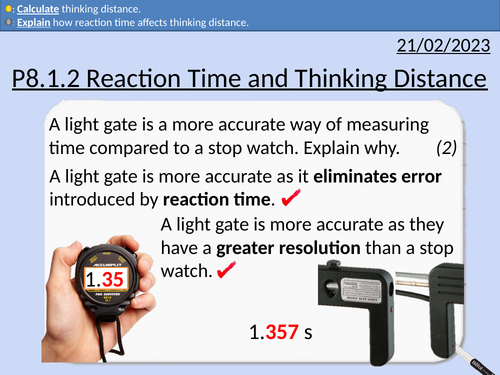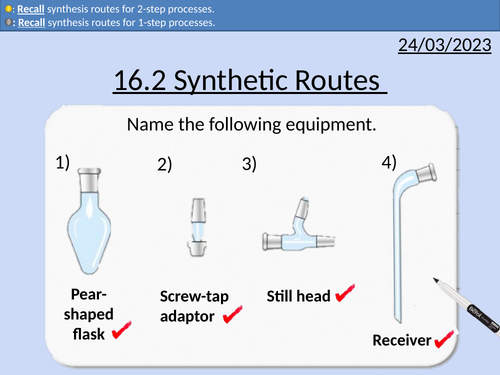484Uploads
147k+Views
65k+Downloads
All resources

OCR AS Physics: Electrical Energy & Power
OCR AS Physics: Electrical Energy & Power is a part of the Module 4: Electrons, Waves, and Photons. PowerPoint with worked examples and homework.
Derive three equations for electrical power
Applying electrical power equations
Create a circuit diagram to calculate power
Base units for V A and W.

OCR AS Physics: Internal Resistance
OCR AS Physics: Internal Resistance is a part of the Module 4: Electrons, Waves, and Photons. PowerPoint with worked examples and homework.
Find lost volts and terminal potential difference from a source of emf
Calculate internal resistance of a cell
Calculate internal resistance of a cell with a graph
Calculate EMF of a source

OCR AS Physics: Wave Properties
OCR AS Physics: Wave Properties is a part of the Module 4: Electrons, Waves, and Photons. PowerPoint with worked examples and homework.

GCSE Physics: Electrical Current
This presentation covers OCR Gateway Physics 9-1 P3.1.2 Electrical Current
Conditions for current to flow
Conventional current and electron flow
Measuring current with ammeters
Current at junctions
Converting from mA to A
Rearranging equations
Determining current and charge flow with equation

GCSE Physics: Transformers
This lesson presentations covers OCR Gateway Physics 9-1 P4.2.5 Transformers.
Examples of transformers in everyday life
Structure of a transformer Step-up and Step-down transformers
Transformer equation and rearranging equations.
Worked Examples and Student problems with worked solutions.
Explanation for use of step-up transformers - efficiency

GCSE Physics: Density
This presentation covers OCR Gateway Physics 9-1 P1.2.1
Presentation includes
Calculating volume for regular shapes
Conversion from grams (g) to kilograms (kg) and centimetres (cm) to meters (m) with exercise and answers
Converting with standard form with examples and solutions
Applying the density equation with examples and solutions
Proportionalities
Plenary exam question and solution

GCSE Physics: Specific Heat Capacity
This presentation covers OCR Gateway Physics 9-1 P1.2.3
Presentation includes:
Definition of SHC
Real life examples of SHC
SHC equation with example
SHC equation questions with worked solutions
Exam question with solution

GCSE Physics: Nuclear Equations
This presentation covers OCR Gateway Physics 9-1 P6.1.3 Nuclear Equations
All presentations come with student activities and worked solutions.
Nuclear Notation - mass number and atomic number
Nuclear equations for emissions of:
Alpha radiation
Beta radiation
Gamma radiation

OCR A level Physics: Solids, Liquids and Gases
OCR A level Physics: Solids, Liquids and Gases is a part of the Module 5: Newtonian World and Astrophysics. The PowerPoint presentation includes worked examples, solutions and a homework.

OCR A Level Physics: Newton's Law of Gravitation
OCR A Level Physics:Newton’s Law of Gravitation presentation, homework and answers.

OCR A Level Physics: Gravitational Fields
OCR A Level Physics: Gravitational Fields presentation, homework and answers.

GCSE Physics: Work Done, Kinetic and Thermal Energy
This presentation covers OCR Gateway Physics 9-1 P7.1.3 Work Done, Kinetic and Thermal Energy
Comes complete with students activities and fully worked solutions.
Energy transfers to thermal store.
Thermal energy, equation, and specific heat capacity.
Work done equation and kinetic energy equation.
Rearranging equations.
Applying equations.
Student questions with fully worked solutions.

OCR AS Chemistry: Properties of Alcohols
OCR AS Chemistry: 14,1 Properties of Alcohols
This PowerPoint is a whole lessons included with student activities, animated answers, homework questions with answers provided.
This lesson covers:
Naming alcohols
Classifying alcohols (primary, secondary, tertiary)
Electronegativity
Polar and non-polar molecules
Explaining physical properties of alcohols compared to alkanes
Volatility
Solubility
Melting points
Chain length and London forces

GCSE Physics: Electrical Heating
This presentation covers OCR Gateway Physics 9-1 P7.2.3 Electrical Heating Transfers. All presentations come with student activities and worked solutions.
Walls and Insulation
Thermal energy dissipation
Reducing thermal energy dissipation with lubrication and insulation
Heating substances and state changes
Work done = Power x Time
Change in thermal energy = Mass x Specific Heat Capacity x Change in temperature
Thermal energy for state change = Mass x Specific latent heat

GCSE Physics: Efficiency
This presentation covers OCR Gateway Physics 9-1 P7.2.5 Efficiency.
All presentations come with student activities and worked solutions.
Efficiency Ratings
Improving efficiency with insulation and lubrication
Maximum efficiency
Efficiency equation
Sankey diagrams

GCSE Physics: Everyday Motion
This presentation covers OCR Gateway Physics 9-1 P8.1.1 Everyday Motion. All presentations come with student activities and worked solutions.
Average speeds of walking, running, cycling, cars, trains, wind, sound, and light.
The speed equation
The acceleration equation
Explaining average speed camera
Explaining instantaneous speed camera
Estimating everyday accelerations
Calculating speed from rotation speed and circumference of wheels
Converting from miles per hour to meters per second

GCSE Physics: Reaction Time and Thinking Distance
This presentation covers OCR Gateway Physics 9-1 P8.1.2 Reaction Time and Thinking Distance. All presentations come with student activities and worked solutions.
Reaction time definition
Factors that increase reaction time
Simple reaction time experiment
Thinking distance
Rearranging equations
Speed equation
(Final velocity)2 – (Initial velocity)2 = 2 x Acceleration x Distance
v2 – u2 = 2 a s

OCR AS Chemistry: Synthetic Routes
OCR AS Chemistry: 16.2 Synthetic Routes
This PowerPoint is a whole lessons included with student activities, animated answers, homework questions with answers provided.
This lesson covers:
Functional Groups - Alkane, Alkene, Haloalkane, Alcohols, Carboxylic Acid, Ketone, Aldehyde, Ester, Amine, Nitrile.
One-step synthetic routes with reagents and conditions
Two-step synthetic routes with reagents and conditions

OCR AS Chemistry: 17.1 Mass Spectrometry
OCR AS Chemistry: 17.1 Mass Spectrometry
This PowerPoint is a whole lessons included with student activities, animated answers, homework questions with answers provided.
This lesson covers:
Molecular ions M+
M + 1 peak
Fragment ions
Identifying molecules from a mass spectrum
Bundle

OCR AS Chemistry: Module 4 Organic Chemistry
This bundle includes all PowerPoint lessons for Module 4 Organic Chemistry.
All PowerPoints are whole lessons included with student activities, animated answers, homework questions with answers provided.
Basic concepts of organic chemistry
Organic Chemistry
Nomenclature of organic compounds
Representing the formulae of organic compounds
Isomerism
Introduction to reaction mechanisms
Alkanes
Properties of the alkanes
Chemical reactions of the alkanes
Alkenes
Properties of the alkenes
Stereoisomerism
Reactions of alkenes
Electrophilic addition in alkenes
Polymerisation in alkenes
Alcohols
Properties of alcohols
Reactions of alcohols
Haloalkanes
The chemistry of haloalkanes
Organohalogen compounds in the environment
Organic Synthesis
Practical techniques in organic chemistry
Synthetic routes
Spectroscopy
Mass spectrometry
Infrared spectroscopy










